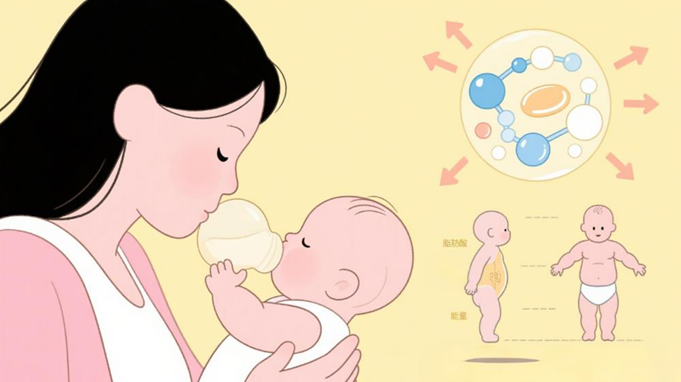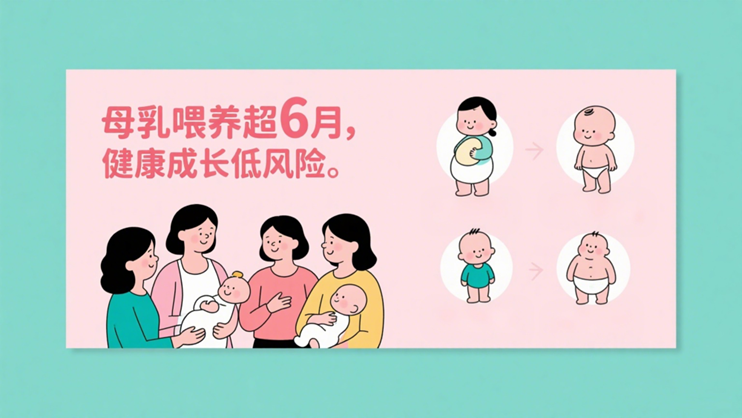世界母乳喂养周:出生后“第一口奶”,藏着宝宝一生的健康密码 | 健康素养66条
来源:CHTV百姓健康频道2025-07-26 20:21:24
作为宝宝生命的第一份礼物,母乳为何如此重要?

给宝宝的“第一份礼物”:
母乳喂养守护近期健康

藏在乳汁里的“长远保障”:
母乳喂养影响终身健康
母乳的影响,远不止婴儿期。就像播下一颗健康的种子,它会在孩子成长的每一步生根发芽。
研究发现,母乳喂养的孩子平均智商得分比非母乳喂养的孩子高3.4分,且喂养时间越长,这种优势越明显[9]。这背后,是母乳中丰富的营养在“铺路”——比如DHA,占大脑额叶皮层总脂肪酸的15%,是神经细胞发育的“关键建材”,而母乳中的神经鞘磷脂还能促进突触形成,让大脑“信息高速公路”更通畅[10]。
再看代谢健康。生命早期的营养模式,会影响成年后的体重和代谢。母乳喂养超过6个月,能让孩子肥胖风险降低22%。这是因为母乳中的12,13-二羟基-9Z-十八碳烯酸能激活棕色脂肪,像“小炉子”一样燃烧多余热量,减少胰岛素抵抗[11]。反之,若母乳中n-6/n-3脂肪酸比例失衡,可能增加孩子远期肥胖风险,这也是为什么乳母饮食需要均衡[12]。

更令人惊讶的是,母乳喂养还会影响免疫系统的“记忆”。一项对3500名儿童的长期追踪发现,母乳喂养超过3个月,能降低学龄前哮喘风险——因为母乳低聚糖会“训练”肠道菌群,让免疫系统更“成熟”,减少过度反应。而过早断奶的孩子,肠道中可能提前出现活泼瘤胃球菌,干扰免疫调节,增加哮喘隐患[13]。
妈妈的“健康回馈”:
母乳喂养是双向的滋养
母乳喂养从来不是“单方面付出”,对妈妈来说,它也是一份珍贵的“健康礼物”。
最直接的是产后恢复。宝宝的吸吮会刺激催产素分泌,帮子宫收缩、减少出血,就像给子宫“按下复位键”。坚持哺乳6个月以上,妈妈产后体重滞留的风险会明显降低,这比任何“减肥食谱”都更天然有效[14]。
从长远看,母乳喂养是女性健康的“保护伞”。数据显示,哺乳超过1年,乳腺癌风险降低26%,卵巢癌风险降低37%,远期2型糖尿病风险降低32%。这是因为哺乳会抑制雌激素波动,减少对乳腺和卵巢的“刺激”[15];同时,乳汁分泌过程能调节母体代谢,改善胰岛素敏感性。长期哺乳甚至能降低10%-15%的心血管疾病风险,让妈妈的健康“保质期”更长[16]。
科学喂养有方法:
这样做让母乳喂养更高效
知道了母乳喂养的好处,更要掌握科学的方法,让这份滋养发挥最大作用。

首先,“早”是关键。世界卫生组织(WHO)推荐指出,宝宝出生后应尽早开奶,哪怕是早产儿,也建议在生命最初几小时内开始接触母乳。产后最初几周是乳腺“启动”的关键期,错过这个阶段,可能影响后续泌乳能力[17]。
其次,坚持“6个月纯母乳+合理添辅食”。WHO推荐,6个月内纯母乳喂养,不加水、果汁或配方奶,因为母乳的营养已经足够。6个月后逐步添加辅食,但母乳喂养可以持续到2岁及以上[18]。
亲喂是最优选择,既能传递免疫细胞,又能促进母婴情感联结。如果需要将乳汁吸出并冷藏/冷冻保存,要注意储存细节:室温25℃以下不超过4小时,冷藏2-4℃不超过96小时,冷冻-20℃可存6-12个月,避免细菌滋生。记得标注吸奶时间,尽量按“晨乳喂白天、夜乳喂夜晚”的规律,不打乱宝宝的生物钟——因为夜乳中褪黑素多,能帮宝宝建立睡眠周期[19]。
乳母的状态也很重要。保持正常体重、每天吃25-30g优质蛋白(比如鱼、蛋、豆类)、每周150分钟中等强度运动,能让乳汁质量更好。即便是超重妈妈,通过合理饮食和运动,也能改善乳汁中的脂肪酸比例,给宝宝更健康的营养[20,21]。
结语:
用坚持书写“健康第一页”

从第一口初乳到长期哺乳,母乳喂养就像为宝宝的人生写下“健康第一页”。它不仅是营养的传递,更是免疫力、情感联结和长远健康的“投资”。
今年世界母乳喂养周,让我们记住:支持母乳喂养,不只是妈妈一个人的事。家庭要多一份理解,职场要多一处哺乳室,社会要多一份包容。当每个宝宝都能顺利喝上母乳,当每个妈妈都能获得足够支持,我们守护的,就是无数个家庭的健康未来。
毕竟,这口带着温度的“第一口奶”里,藏着的是生命最初的力量,和对未来最温柔的守护。
参考文献:
[1] Szyller H, Antosz K, Batko J, et al. Bioactive Components of Human Milk and Their Impact on Child's Health and Development, Literature Review. Nutrients. 2024;16(10):1487.
[2] Yi DY, Kim SY. Human Breast Milk Composition and Function in Human Health: From Nutritional Components to Microbiome and MicroRNAs. Nutrients. 2021;13(9):3094.
[3] Donald K, Petersen C, Turvey SE, et al. Secretory IgA: Linking microbes, maternal health, and infant health through human milk. Cell Host Microbe. 2022 May 11;30(5):650-659.
[4] Horta BL, Victora CG. Short-term effects of breastfeeding: a systemic review on the benefits of breastfeeding on diarrhea and pneumonia mortality[DB/OL]. WHO. 2013-03-08.
[5] Perrone S, Longini M, Zollino I, et al. Breast milk: To each his own. From metabolomic study, evidence of personalized nutrition in preterm infants[J]. Nutrition, 2019,62:158-161.
[6] Amari S, Shahrook S, Namba F, et al. Branched-chain amino acid supplementation for improving growth and development in term and preterm neonates. Cochrane Database Syst Rev. 2020;10(10):CD012273.
[7] 郭倩颖,等. 高学历产妇产后不同阶段母乳成分及喂养方式变化的随访. 中国生育健康杂志, 2017, 28(1): 6-9.
[8] World Health Organization. Energy and protein requirements: report of a joint FAO/WHO/UNU expert consultation. WHO Technical Report Series 724. Geneva: World Health Organization; 1985.
[9] Horta BL, Loret de Mola C, Victora CG. Breastfeeding and intelligence: a systematic review and meta-analysis[J]. Acta Paediatr,2015,104(467):14-19.
[10] Peters S, Yang L, Guo Y, et al. Breastfeeding and the risk of maternal cardiovascular disease: a prospective study of 300 000 Chinese women[J]. J Am Heart Assoc, 2017,6(6):e006081.
[11] Isganaitis E. Milky ways: effects of maternal obesity on human milk composition and childhood obesity risk[J]. Am J Clin Nutr, 2021,113(4):772-774.
[12] Vasan SK, Noordam R, Gowri MS, et al. The proposed systemic thermogenic metabolites succinate and 12,13-diHOME are inversely associated with adiposity and related metabolic traits: evidence from a large human cross-sectional study[J]. Diabetologia, 2019,62(11):2079-2087.
[13] Shenhav L, Fehr K, Reyna ME, et al. Microbial colonization programs are structured by breastfeeding and guide healthy respiratory development. Cell. 2024;187(19):5431-5452.e20.
[14] 中华医学会围产医学分会. 母乳喂养对产妇恢复的积极作用. 中华围产医学杂志, 2024, 27(1): 45-48.
[15] Chowdhury R, Sinha B, Sankar MJ, et al. Breastfeeding and maternal health outcomes: a systematic review and meta-analysis[J]. Acta Paediatr,2015,104(467):96-113.
[16] Peters S, Yang L, Guo Y, et al. Breastfeeding and the risk of maternal cardiovascular disease: a prospective study of 300 000 Chinese women[J]. J Am Heart Assoc, 2017,6(6):e006081.
[17] World Health Organization. Early initiation of breastfeeding to promote exclusive breastfeeding [Internet]. Geneva: WHO; 2021 [cited 2025 Jul 25].
[18] World Health Organization; United Nations Children’s Fund. Protecting, promoting and supporting breastfeeding in facilities providing maternity and newborn services: revised guidelines. Geneva: WHO; 2025.
[19] National Center for Biotechnology Information. Storage, handling, and administration of expressed human breast milk: a review of guidelines [Internet]. Bethesda (MD): NIH; 2016.
[20] 中国营养学会. 中国居民膳食指南(2022)[M]. 北京: 人民卫生出版社, 2022.
[21] Bravi F, Wiens F, Decarli A, et al. Impact of maternal nutrition on breast-milk composition: a systematic review[J]. Am J Clin Nutr, 2016, 104(3): 646-662.

 CHTV 百姓健康微信
CHTV 百姓健康微信